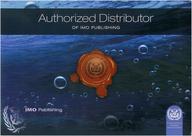Catálogo - LIBROS NÁUTICOS - Transporte marítimo, Fletamentos, Economía Marítima y Puertos
Reeds Sea Transport. Operation and Economics
Autor: Patrick M. Alderton
Editorial: Adlard Coles Nautical
Año de edición: 2011 (6ª edición)
9781408131428
Encuadernación: rústica
324 pág.
15,0 x 21,0 cm.
47,50€
Contenido:
This book gives a complete picture of the Maritime Transport Industry so that those involved with shipping can sea their own specific field of interest in perspective, and understand how the basic model of this mode of transport operates.
Modern Transport professionals must be able to adapt to and anticipate the implications of changes in the industry; this book gives an insight into how management has coped with change over the last century, and enables the reader to see how this essential commercial activity has developed.
This new edition has been updated throughout to take account of developments in the industry. It includes new data and statistics, new advice on safety, a review of ship types and sizes including the latest designs of Ro-Ro ferries and bulk carriers, and a revised chapter on marine finance to analyze the impact of the recent global credit problems on the shipping industry. Also new measures of efficiency in logistics and management have been included. All of which make this essential reading for professionals as well as students on courses concerned with Shipping, Ports and Transport.
Índice:
Acknowledgments
Preface
1. THE SHIP
The number and classification of ships
Parts of the ship
Ship stresses and stability
Markings on the ship
Tonnage
2. TYPES OF SHIPS
The passenger ship
The general cargo ship
The container ship
Barge-carrying ships
Ro/Ro ships
The bulk carrier
Specialist ships
Types of engines
Power measurement, requirement and fuel consumption
3. TYPES AND TRENDS
Trends in ship types
The economics of ship size
The economics of speed
4. THE CREW
Typical duties
Reductions in crew size
The international supply of seafarers
How crew sizes are regulated
Crew training
Industrial relations
5. NAVIGATION
Whose responsibility is this?
The choice of route
Navigational hardware
Communications at sea
6. TYPES OF CARGO
Basic definitions
Pre-shipment planning
The stowage plan
Stowage and discharge
The care of cargo during the voyage
Stuffing containers
Bulk cargo
Dangerous cargoes
Deck cargo
7. WHY CARGO IS MOVED
The theory of trade
Supply v demand. The essence of the problem
8. COST AND FREIGHT RATES
Cost classification
Administration costs
The Daily Running Cost (DRC)
Cost of bunkers
Freight rates... the key to the problem
9. WORLD TONNAGE
Supply of shipping
The growth of nautical merchant fleets
Reasons for encouraging and sustaining national fleets
Maritime policy
What are flags of convenience?
10. SHIPPING FINANCE
Introduction
Shipping and the global financial crisis
Types of funding
11. DRY CARGO, TRAMP AND TANKER MARKETS
Different ways of chartering a ship
Standard forms for charters
Voyage estimating
Obtaining the "offers"
The final reckoning
Arbitration
Differences in the tanker market and tanker chartering
12. THE LINER MARKET AND MULTIMODAL TRANSPORT
Typical company organisation
Marketing
Conferences, consortia and alliances
Logistics and/or intermodal transport
13. SAFETY
How serious a problem is safety?
Governmental and international action on safety
Economics of safety
Salvage
Safety and environmetal issues
14. ECONOMICS OF DOCUMENTATION
Economical and operational problems of documentation
15. PORTS
Port development
Classification of ports
Types of port ownership
Port labour
Port management and administration
Port charged
Ship canals
Safety and environmental issues
Appendix A. Voyage estimate using Excel
Appendix B. Distances along the world's major trade routes
Appendix C. Websites
Precio: 47,50 €, I.V.A. incluido (4%)
[ Volver ]

